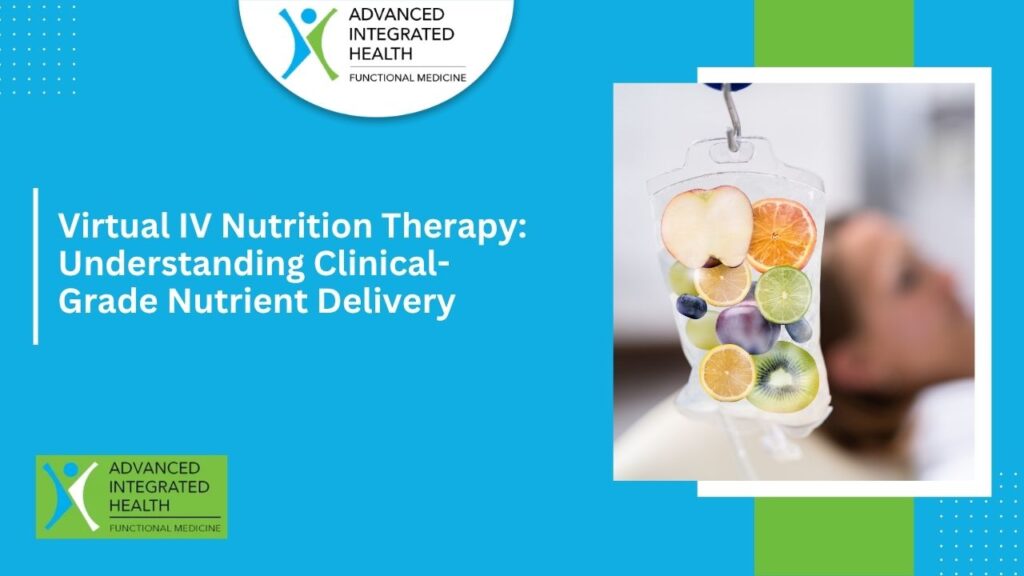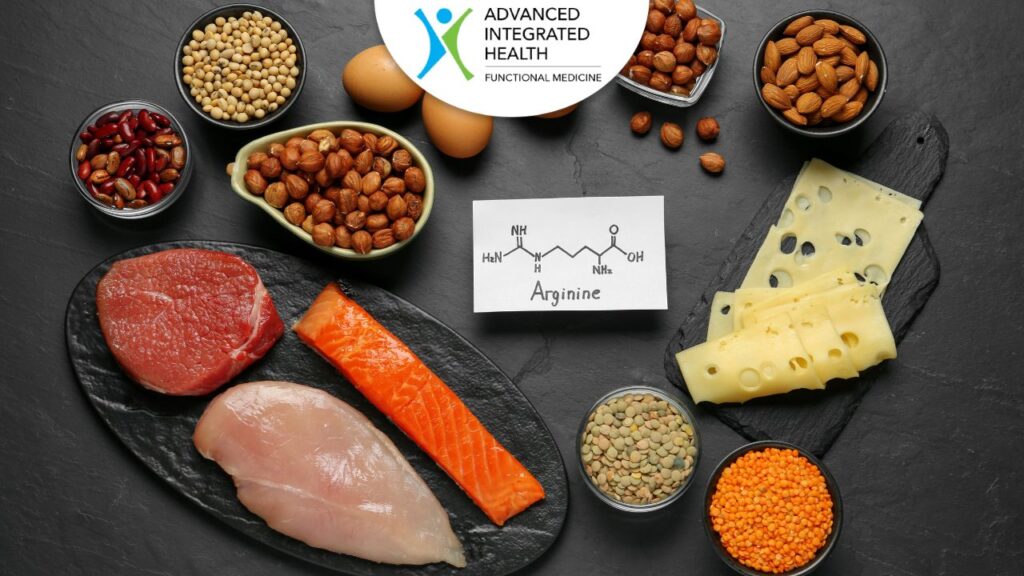An educational exploration of intravenous micronutrient therapy delivered through telemedicine platforms.
What Is IV Nutrition Therapy?
Intravenous (IV) nutrition therapy involves the direct administration of vitamins, minerals, and other nutrients into the bloodstream through a vein. This delivery method bypasses the digestive system, allowing for near-complete absorption of nutrients that might otherwise be poorly absorbed orally due to gastrointestinal limitations, malabsorption disorders, or individual metabolic variations.
Key Differences from Oral Supplementation:
- Bioavailability: IV delivery achieves nearly 100% bioavailability compared to 10-50% for many oral nutrients
- Dosing: Higher therapeutic doses can be achieved safely through IV administration
- Speed: Immediate availability to cells and tissues
- Bypass limitations: Circumvents digestive issues, drug interactions, and individual absorption variations
Virtual IV Therapy: The Telemedicine Evolution
Virtual IV nutrition therapy represents the convergence of telemedicine technology with clinical nutrition practice. This model allows qualified healthcare providers to supervise and guide IV nutrient administration in patients’ homes through real-time video connections.
How Virtual Supervision Works:
- Step 1: Remote Assessment – Comprehensive health history, symptom evaluation, and contraindication screening via secure video platform
- Step 2: Protocol Development – Customized nutrient formulation based on individual needs, lab results, and clinical goals
- Step 3: Home Delivery – Sterile IV supplies and compounded nutrients are delivered to the patient’s location with a trained mobile nurse
- Step 4: Real-Time Supervision – Live video monitoring during infusion with immediate guidance and emergency protocols
Clinical Research and Evidence
Myers’ Cocktail Research
The “Myers’ cocktail,” consisting of magnesium, calcium, B vitamins, and vitamin C, has been studied in controlled clinical trials. A randomized, double-blind, placebo-controlled pilot study involving 34 fibromyalgia patients found that both IV micronutrient therapy and placebo groups showed within-group improvements, with the IV group demonstrating improvements in tender points, pain, depression, and quality of life.
Myers’ Cocktail Components:
- Magnesium chloride hexahydrate (20%)
- Calcium gluconate (10%)
- Hydroxocobalamin (vitamin B12)
- Pyridoxine (vitamin B6)
- Dexpanthenol (vitamin B5)
- B-complex vitamins
- Ascorbic acid (vitamin C)
- Sterile water for injection
NAD+ Therapy Clinical Evidence
Nicotinamide adenine dinucleotide (NAD+) IV therapy has been studied across diverse conditions. A systematic review of 36 human trials found that 17 reported beneficial outcomes, with conditions ranging from neurodegenerative diseases to metabolic disorders.
NAD+ Research Outcomes:
- Parkinson’s Disease: 61.7% showed very good improvement (>30%), 38.3% moderate improvement (≤30%)
- Chronic Fatigue: 31% favorable response with NAD+ vs 8% with placebo
- Skin Health: 88% of patients with actinic keratoses showed decreased lesion size
High-Dose Vitamin C Studies
Intravenous vitamin C has been extensively studied, particularly in cancer research. High-dose IV vitamin C shows potential as a multi-targeting agent when administered intravenously. Studies in critically ill patients found that high-dose IV vitamin C was associated with a significant reduction in overall mortality (relative risk 0.70, 95% CI 0.52-0.96).
Safety Protocols and Standards
USP 797 Compliance
The United States Pharmacopeia (USP) Chapter 797 establishes standards for pharmaceutical compounding of sterile preparations. USP 797 requirements apply to all persons and places that prepare compounded sterile preparations for human patients, including IV nutrition formulations.
Key Safety Requirements:
- Sterile Compounding: All IV preparations must be prepared in controlled environments
- Personnel Training: Written protocols and documented training for all staff
- Environmental Controls: Proper air quality, temperature, and humidity controls
- Quality Assurance: Regular testing and validation of sterile processes
- Beyond Use Dating: Strict adherence to stability and expiration guidelines
Contraindications and Screening
Proper patient screening is essential before IV nutrient therapy. Certain conditions require special consideration or may contraindicate IV therapy altogether.
Absolute Contraindications
- Severe kidney disease
- G6PD deficiency (for high-dose vitamin C)
- Iron overload disorders
- Active cardiac failure
- Severe electrolyte imbalances
Relative Contraindications
- Pregnancy and breastfeeding
- Recent myocardial infarction
- Uncontrolled hypertension
- Active infections
- Certain medications
Clinical Applications and Indications
IV nutrition therapy has been studied and applied across various clinical conditions, though evidence quality varies. It’s important to note that IV therapy should complement, not replace, conventional medical treatment.
Fatigue and Energy
- Chronic fatigue syndrome
- Adrenal insufficiency
- Post-viral fatigue
- Fibromyalgia
- Athletic recovery
Immune Function
- Recurrent infections
- Seasonal allergies
- Upper respiratory infections
- Chronic sinusitis
- Immune system support
Neurological Conditions
- Migraine headaches
- Cognitive decline
- Depression and anxiety
- Neuropathy
- Brain fog
Digestive and Absorption Issues
- Inflammatory bowel disease
- Celiac disease
- Malabsorption syndromes
- Post-surgical nutrition
- Severe nutrient deficiencies
Cardiovascular and Metabolic
- Hypertension
- Metabolic syndrome
- Diabetes support
- Cardiovascular disease
- Acute muscle spasm
Common Nutrient Formulations
Myers’ Cocktail
The classic formulation contains magnesium, calcium, B vitamins, and vitamin C. Studies suggest effectiveness against acute asthma attacks, migraines, and fatigue.
Typical components: Magnesium chloride, calcium gluconate, vitamin B12, B6, B5, B-complex, vitamin C
High-Dose Vitamin C
Ascorbic acid, in doses typically ranging from 15-100 grams, is used for immune support and as adjunctive therapy in various conditions.
Note: Requires G6PD screening due to the risk of hemolysis in deficient individuals
Glutathione
The body’s master antioxidant, administered as an IV push or added to other formulations for detoxification support and cellular protection.
Applications: Liver detox support, antioxidant therapy, neurological conditions
NAD+ Infusions
Nicotinamide adenine dinucleotide is used for cellular energy production and DNA repair. Studies show potential benefits for neurodegenerative conditions and aging.
Duration: Typically requires 2-4 hours of infusions due to potential side effects at higher infusion rates
Regulatory and Legal Considerations
Virtual IV therapy operates within a complex regulatory framework that varies by state and jurisdiction. Healthcare providers must navigate multiple levels of compliance.
Federal Requirements
- DEA registration for controlled substances
- FDA compounding regulations
- HIPAA compliance for telemedicine
- USP 797 sterile compounding standards
State-Level Considerations
- Medical practice licensing
- Nursing scope of practice laws
- Telemedicine regulations
- Home care organization licensing
Professional Supervision Requirements
In most jurisdictions, IV therapy must be performed under the supervision of a licensed physician, with administration by qualified nursing personnel. Virtual supervision models must comply with state-specific telemedicine and nursing practice regulations.
Limitations and Important Considerations
Evidence Quality
While promising, much of the research on IV nutrition therapy consists of small studies, case reports, or uncontrolled trials. Systematic reviews note a lack of high-quality evidence for many claimed benefits of IV vitamin therapy.
Cost Considerations
IV nutrition therapy is typically not covered by insurance when used for wellness purposes. Patients should understand the financial investment and consider the cost-benefit ratio compared to conventional treatments.
Not a Replacement for Conventional Care
IV nutrition therapy should be viewed as complementary to, not a replacement for, evidence-based medical treatments. Patients should maintain regular relationships with their primary healthcare providers.
Individual Variation
Response to IV therapy varies significantly between individuals. Factors including genetics, underlying health conditions, medication interactions, and lifestyle factors all influence outcomes.
Summary and Future Directions
Virtual IV nutrition therapy represents an innovative intersection of telemedicine technology and clinical nutrition practice. While early research shows promise for certain conditions, the field would benefit from larger, well-controlled studies to establish optimal protocols and identify patients most likely to benefit.
The convenience and accessibility of virtual supervision models may increase access to IV nutrition therapy for patients who cannot easily travel to clinical facilities. However, this must be balanced against the need for appropriate safety protocols, professional oversight, and regulatory compliance.
Key Takeaways:
- IV nutrition therapy bypasses digestive absorption limitations
- Virtual supervision models enable home-based delivery of clinical-grade treatments
- Safety protocols and professional oversight are essential
- Evidence quality varies significantly across different conditions and formulations
- Individual patient factors strongly influence treatment response
- Regulatory compliance requirements vary by jurisdiction
As the field continues to evolve, ongoing research, improved standardization of protocols, and clear regulatory frameworks will be essential to optimize patient safety and treatment outcomes in virtual IV nutrition therapy.

Dr. Bob was born and raised in Florham Park, New Jersey.
He loved the philosophy of vitalism, which teaches about the incredible, innate intelligence of our bodies and its power to self-heal when given the opportunity.


